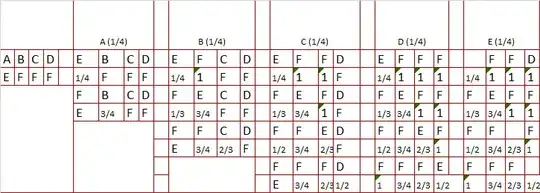HINT:
Here is a demonstration of a simpler configuration: we begin with the pattern ABCD on top rows and EFGH on bottom rows. In this case, The approach is straightforward, but tracing takes some patience. Hope this provides some insight.
Let P(A) and P(B) represent the probabilities of each one of two players being able to take A, B, C, D, E in that order. The probability for both to be successful is P(A)$\cdot $P(B), where P(A)=P(B).
In this picture , F,G,H can be treated the same, we can use F,F, F to simplify the picture. Every time you draw from top row, you only have $\frac{1}{4}$ chance to be correct. Pay attention to separate move ups of E and F as illustrated.
For example, for 1st step to take A out from first row , the probability is $\frac{1}{4}$.When you move a letter up to fill A's position from second row, the probability for E is $\frac{1}{4}$ , while for F is $\frac{3}{4}$ . With some analysis, it is concluded there are three paths leading to a successful game. For each path, trace the success possibilities for every step and multiply them, we get the success rate for that path.
Adding everything together:
$P(A)=P(B)=(\frac{1}{4})^6+\frac{1}{4}\frac{3}{4}\frac{1}{4}\frac{1}{3}\frac{1}{4}\frac{1}{2}\frac{1}{4}\frac{1}{1}\frac{1}{4}+\frac{1}{4}\frac{3}{4}\frac{1}{4}\frac{2}{3}\frac{1}{4}\frac{1}{2}\frac{1}{4}\frac{1}{1}\frac{1}{4}=(\frac{1}{4})^6(1+\frac{1}{2}+1)$
$P(A)P(B)=(\frac{1}{4})^{12}(\frac{5}{2})^2=25\cdot (\frac{1}{4})^{13}\approx 3.7252902985×10^{−7}$
What a chance!

